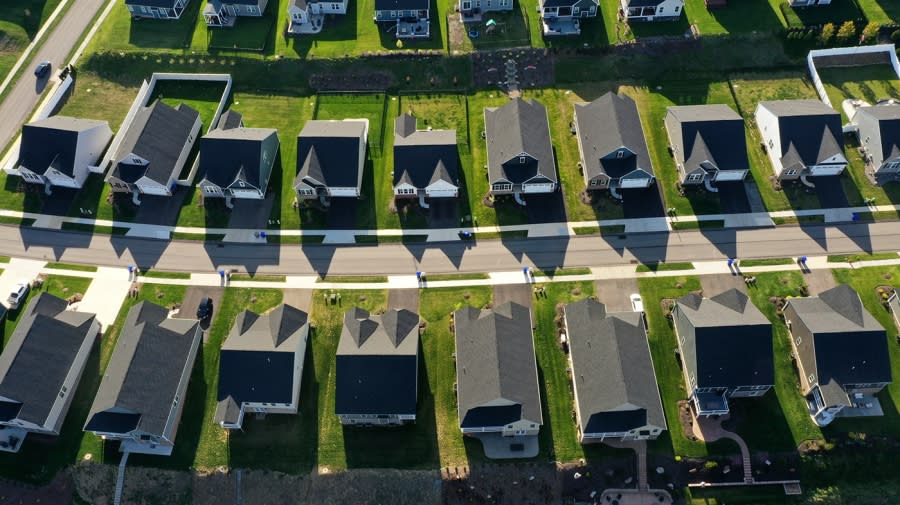High housing costs push inflation up ahead of Fed meeting
Housing costs continued to drive inflation in May, even as the annual growth rate reached its slowest pace since March 2021.
Consumer prices rose just 0.1 percent last month and are up 4 percent since last year, according to the consumer price index released Tuesday by the Labor Department.
But the cost of housing increased by 0.6 percent from April, making it the largest factor in the monthly increase in inflation. Prices are now 8 percent higher than they were a year ago on an unadjusted basis.
Even so, economists expect the slowdown to persuade the Federal Reserve to pause a series of interest rate hikes that have hampered housing affordability over the last year.
Can the U.S. afford this inflation? Debt deal strikes blow to housing affordability
“Inflation calmed down in May, and further deceleration looks likely in the upcoming months. It also marks the first month in two years that wage growth outpaced consumer price inflation, improving the average standard of living, said Lawrence Yun, chief economist at the National Association of Realtors (NAR) in a statement.
“Moreover, low inflation means that the Federal Reserve should stop raising interest rates and possibly slash rates towards the year-end or early next year,” he added.

Mortgage rates are back up despite a brief cooling pause
The central bank’s effort to bring down inflation to its target 2 percent rate drastically cooled the housing market since last March and sent monthly costs for buyers soaring.
Mortgage rates during the fed’s monetary tightening period shot up from historic lows early in the pandemic to more than 7 percent by late last fall. After a short reprieve earlier this year, rates are back near their high mark.
Rates are still rising: Daily mortgage rates reach highest level since November
The benchmark 30-year fixed rate mortgage jumped to 6.79 percent last week, according to data from Freddie Mac.
These fluctuating rates have hindered buyers and sellers, at times pushing the former out of the market altogether while enticing the latter to keep their homes off of the market at a time when inventory is low.
Builders are scrambling to build amid record high prices
Meanwhile, elevated costs amid tightened lending standards are also hindering builders who are aiming to fill the housing supply gap with new construction.
“Shelter costs remain elevated and persistent source of inflation pressure due to challenges with respect to the cost and availability of housing. For single-family homes, there is a significant deficit, which is increasing the cost of attaining homeownership,” Robert Dietz, chief economist for the National Association of Home Builders (NAHB), told The Hill in an email.
“And new construction, which is attempting to fill the inventory gap, is suffering from higher costs for materials, labor, lots, and regulatory burdens. Rental housing costs are also higher due to these increases for development costs, which is pushing shelter inflation higher,” he added.
The rental side of the housing market has also been impacted because prospective buyers are often forced to continue to rent.

Rental costs are easing despite owners wanting more money
CPI figures indicate rents are cooling alongside asking rents that have dropped in various parts of the country.
“The shelter component of CPI is quite lagged, so real housing market activity will only start to show up in the data about 6-12 months after it happens in the economy,” Yelena Maleyev, an economist with KPMG, told The Hill in an email.
Yet Maleyev said rents are finally inching down on a year-over-year basis after ticking up for three straight months and are starting to reflect the decline in rents in parts of the U.S.
Still, the owners’ equivalent rent, a measure reflecting how much owners believe their property is worth, remains “stubbornly high” at 8 percent, she added. She said this point is the most concerning to her.
“We have already seen home prices reverse course in some hotter markets and start to reaccelerate, while the areas that saw home price declines may soon see a bottoming out,” Maleyev continued.
Getting priced out: Cash buyers purchasing one-third of homes: report
“This bottoming out and price reversal, even in a high mortgage rate environment, is the reason why the Bank of Canada surprised markets with a rate hike this month. The same could happen here,” she said.
But NAHB’s Dietz warned that further rate hikes could backfire as a means to cool inflation.
“Conventional wisdom holds that higher interest rates will cool inflation. However, the hot number for shelter inflation are due to a lack of housing,” Dietz said. “Higher interest rates increase the cost of new construction and limit supply, producing the counterintuitive effect of contributing to more shelter inflation.”
For the latest news, weather, sports, and streaming video, head to The Hill.

